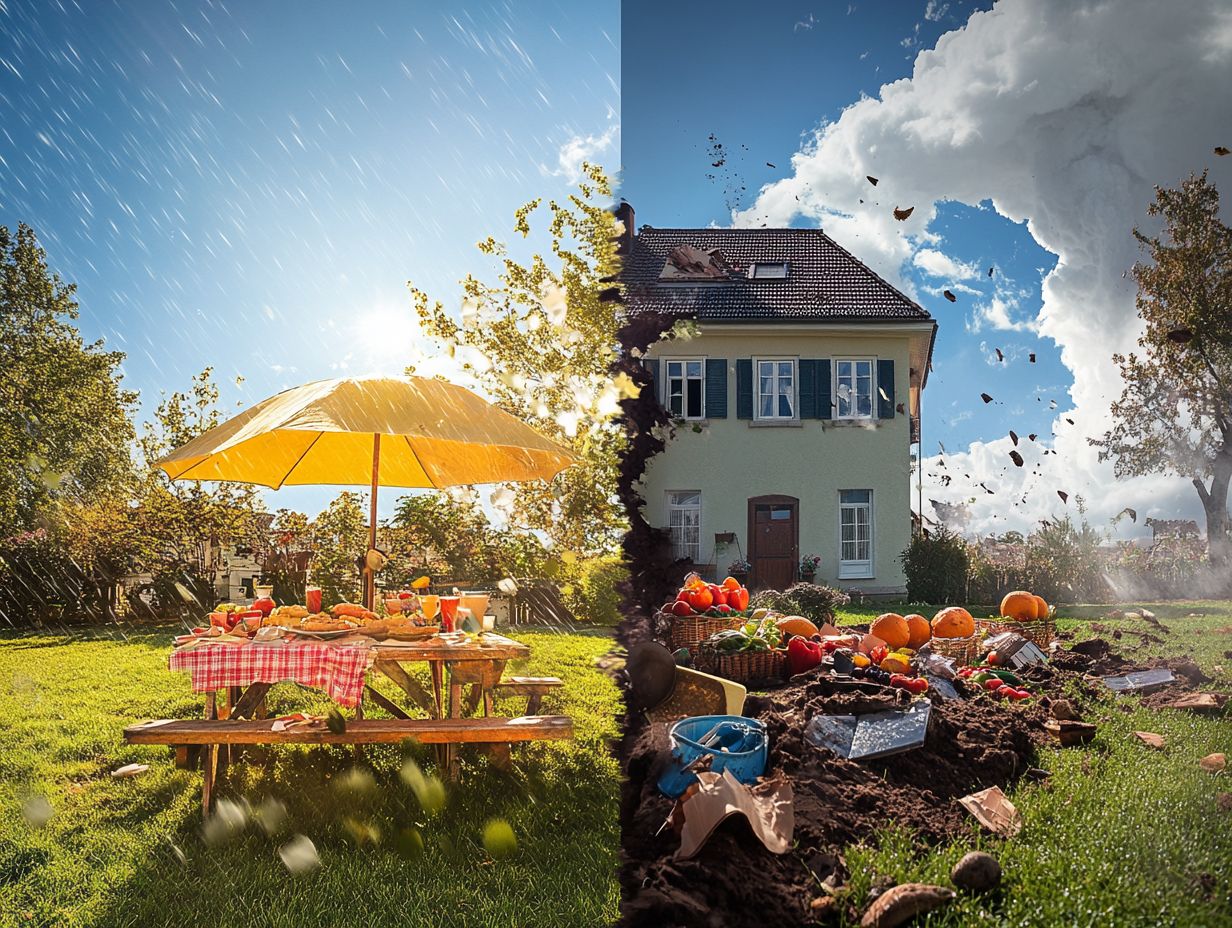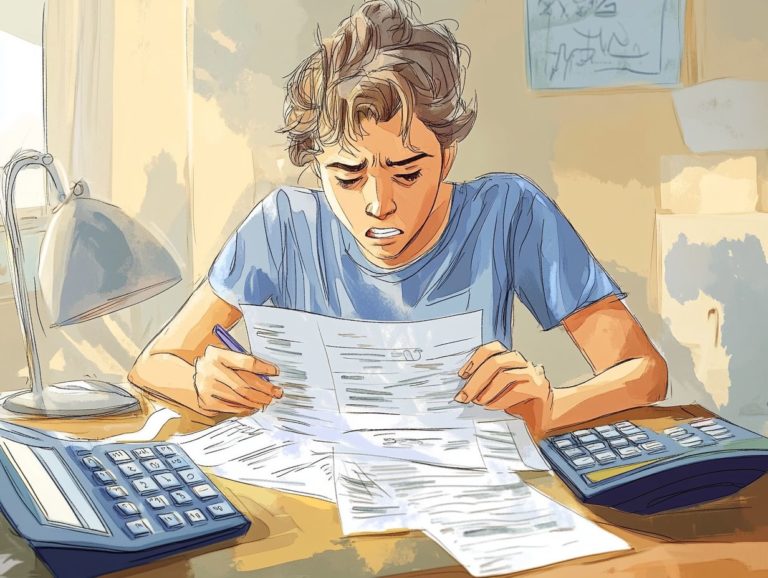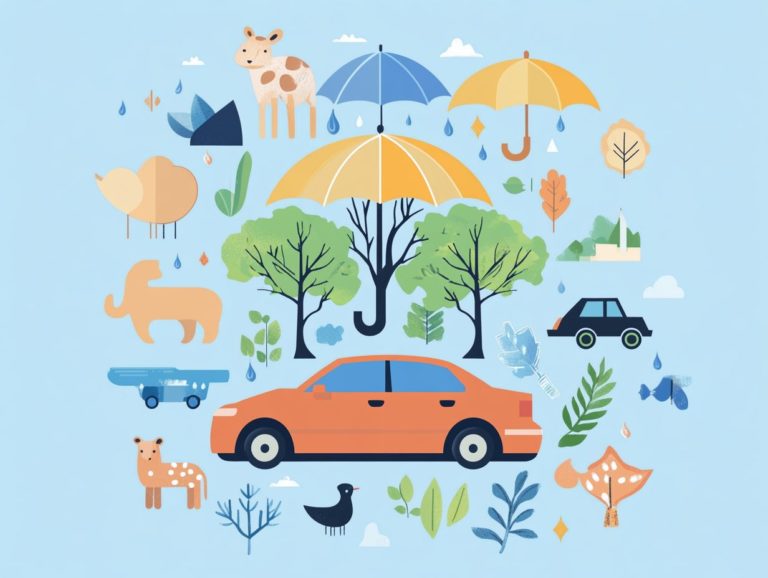How Does Weather Affect Insurance Rates?
Weather plays a big role in shaping insurance rates. Your premiums often depend on geographic risks and historical weather data.
From hurricanes to wildfires, various weather events can dramatically affect your premiums. It s essential to understand these factors.
This article looks at what affects insurance rates and the weather events that play a part. You’ll also find strategies to help save on costs.
This article also looks at trends and predictions related to climate change. Discover how to manage this complex situation and uncover potential savings on your insurance premiums.
Contents
- Key Takeaways:
- Understanding Weather-related Insurance Rates
- Types of Weather Events that Affect Insurance Rates
- How Weather Impacts Insurance Premiums
- Ways to Prepare for Weather-related Insurance Costs
- Weather-related Insurance Trends and Predictions
- Frequently Asked Questions
- Ever wondered how weather affects insurance rates?
- Why do insurance rates change based on weather?
- How does severe weather affect home insurance rates?
- Does the frequency of severe weather impact insurance rates?
- Are there specific weather events that can significantly impact insurance rates?
- How can I lower my insurance rates if I live in an area prone to severe weather?
- Does weather also affect car insurance rates?
Key Takeaways:

- Natural disasters and extreme weather can raise your insurance rates.
- Insurers use risk assessment and adjustment strategies to determine weather-related premiums. It’s important for you to prepare and manage potential risks.
- Climate change is expected to significantly impact insurance rates in the future. Staying informed can help you reduce your risk and premiums.
Understanding weather-related insurance rates is essential for you, whether you’re an insurance company or a policyholder, especially given the rise in severe weather events linked to climate change.
These factors can profoundly affect insurance premiums and rates across the market, particularly during hurricane season and after catastrophic weather events in states like Florida and California.
As climate change continues to alter weather patterns, insurance companies must adjust their risk assessment strategies to maintain affordability and sustainability for you, the policyholder.
It’s crucial to assess how these shifts impact claims processing and the overall experience for insurance consumers navigating this unpredictable landscape.
What Factors Influence Insurance Rates?
Several factors influence your insurance rates, especially in the context of how climate change impacts risk assessment by insurance companies.
This evolving landscape is leading to an uptick in severe weather-related events, raising risks across various regions. As global temperatures rise, so do the intensity of hurricanes and the frequency of devastating wildfires. This results in significant property damage, which affects your individual insurance premiums.
Take Florida and California, for example; these areas have seen sharp spikes in rates as insurers adapt to the reality of more frequent claims tied to climate disasters. According to the Insurance Information Institute, homeowners in these regions face average premium increases of 20% or more. This underscores the urgent need for you to grasp how climate change is reshaping the insurance landscape.
Types of Weather Events that Affect Insurance Rates
Different types of weather events can profoundly affect insurance rates. They can result in higher premiums and complicate claims processing for both insurance companies and policyholders.
Natural Disasters and Extreme Weather Conditions

Natural disasters and extreme weather conditions like hurricanes such as Hurricane Idaho can devastate properties. This significantly complicates the claims process for insurance companies.
After such disasters, you face financial challenges, and the entire insurance market feels the pressure. The National Oceanic and Atmospheric Administration (NOAA) has noted a concerning rise in the frequency and severity of natural disasters, with insured losses from hurricane-related damages exceeding $75 billion.
Insurance companies often become overwhelmed with claims immediately following these events. This leads to longer wait times and disputes over coverage. Higher premiums may also appear as insurers adjust their financial strategies to manage the risks of unpredictable weather. Significant claims can also strain smaller insurance providers, threatening their sustainability and leading to market consolidation.
How Weather Impacts Insurance Premiums
Weather has a significant impact on insurance premiums. Climate change complicates risk assessments for insurers and affects affordability for policyholders.
Understanding this relationship is key to making smart choices when navigating your options.
Calculating Risk and Adjusting Rates
Calculating risk and adjusting rates is complex for insurance companies, especially as climate change introduces new variables into their risk models. These firms use various methods to assess potential losses from extreme weather events and environmental shifts.
For example, advanced data analytics helps analyze past claims and predict future incidents, considering factors like rising sea levels and more frequent wildfires. Areas prone to flooding have seen insurance rates surge by up to 25% in just a few years.
This rise impacts both the affordability of coverage and has broader implications for the housing market, driving communities to reassess their risk exposure.
Being prepared for weather-related insurance costs requires a solid understanding of the factors that affect insurance affordability. By taking proactive measures to mitigate risks, you can reduce your premiums and secure a better financial position.
Mitigating Risk and Reducing Premiums

Mitigating risk is essential for lowering premiums and protecting your property from severe weather.
As a homeowner or business owner, consider these actionable steps:
- Invest in weather-resistant materials.
- Conduct regular property inspections.
- Develop emergency plans based on specific geographic risks.
Review and update your insurance policy options to ensure they cover common climate-related events, such as floods, hurricanes, and wildfires.
By taking advantage of discounts for safety features and bundling policies, you can enhance your coverage and make your property more resilient against unpredictable weather challenges.
Weather-related insurance trends and predictions are increasingly influenced by climate change. Companies are adapting to the new challenges posed by extreme weather events, revising their strategies for the future.
You need to act now to protect your assets against potential losses. Review your insurance coverage and consider taking steps to mitigate risks.
Impact of Climate Change and Future Projections
The impact of climate change on insurance companies is profound. Future projections suggest that increasingly volatile weather-related events will challenge existing insurance models.
As the frequency and severity of hurricanes, floods, and wildfires escalate, it s crucial to rethink your approach to risk assessment. This involves not only updating statistical models but also embracing new tools that use data to help predict risks like artificial intelligence and machine learning for greater accuracy in predicting potential losses.
Given these climatic shifts, the insurance industry is reevaluating its pricing strategies. Prepare for potential adjustments in your premiums as they may reflect the heightened risk of coverage, especially for those in high-risk areas.
Insurers are creating new products to tackle these challenges head-on. This ensures both you and the industry are ready for whatever lies ahead.
Frequently Asked Questions
Ever wondered how weather affects insurance rates?

Weather can significantly impact insurance rates. Let s explore some commonly asked questions on this topic.
Why do insurance rates change based on weather?
Insurance rates are based on risk assessment. Severe weather events increase the risk of damage to property and vehicles, leading to higher rates in areas prone to extreme weather.
How does severe weather affect home insurance rates?
Severe weather such as hurricanes, tornadoes, and hailstorms can cause extensive damage to homes. This results in higher insurance claims, which may increase home insurance rates in vulnerable areas.
Does the frequency of severe weather impact insurance rates?
Yes, a rise in severe weather events over time can lead to an increase in insurance rates. Insurance companies may have to pay out more in claims, resulting in higher premiums for customers.
Are there specific weather events that can significantly impact insurance rates?
Hurricanes, tornadoes, and wildfires are among the most costly and damaging weather events. They can drastically affect insurance rates due to widespread damage and a large number of claims.
How can I lower my insurance rates if I live in an area prone to severe weather?
Installing protective measures such as storm shutters, reinforced roofs, and impact-resistant windows can help lower insurance rates. Having a good credit score can also contribute to lower rates.
Does weather also affect car insurance rates?
Yes, weather can significantly impact car insurance rates. Severe weather events, such as hailstorms and floods, can damage vehicles and lead to higher claims, ultimately raising rates in those areas.
Take action now to ensure you’re adequately protected against the elements!






